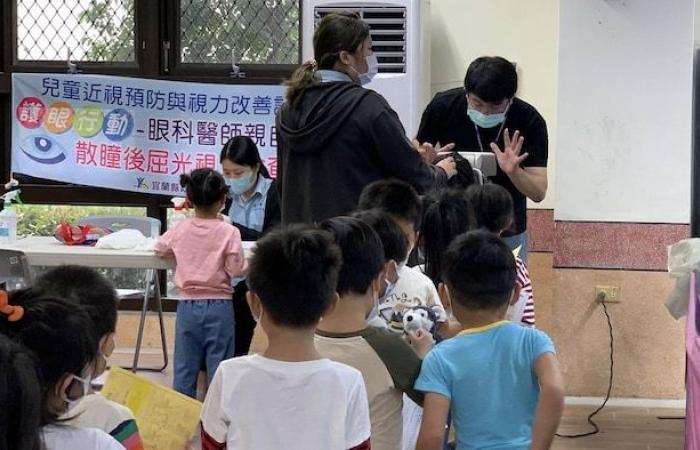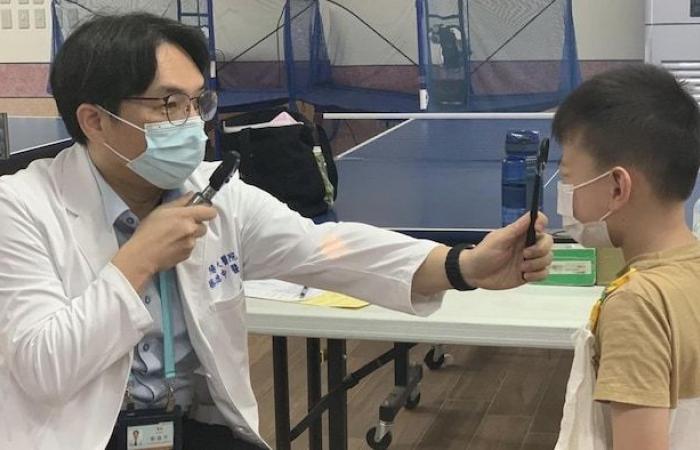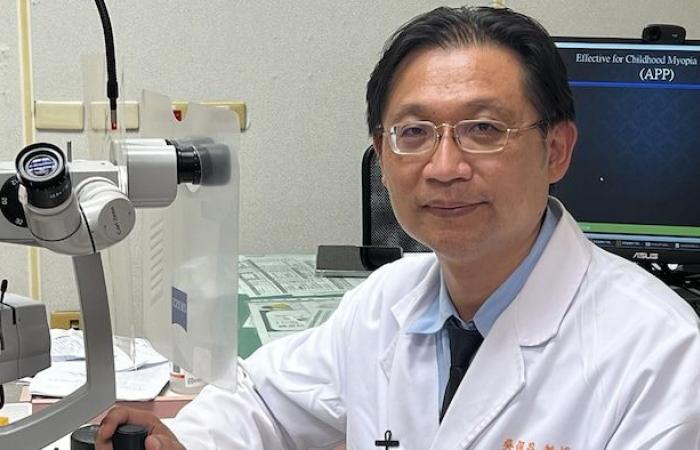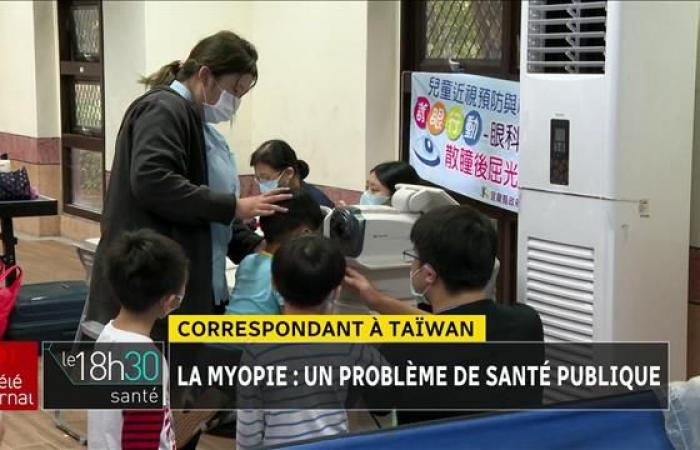Nearly one in three children are myopic worldwide, a proportion that is increasing more rapidly since the COVID-19 pandemic.
This was revealed last September by a study by British Journal of Medicine which involved time spent in front of screens rather than outside.
The myopia epidemic is even more serious in several Asian countries, including Taiwan, where nearly 85% of primary school children have eye problems.
Prevention programs focused on screening and messages repeating the importance of playing outside were set up around ten years ago.
At a small primary school in Yilan County, a corner of the gymnasium was transformed into an ophthalmology clinic for one afternoon at the end of October.
In total, 21 kindergarten students take an annual myopia screening test between the ping-pong tables and exercise mats.
Open in full screen mode
Kindergarten students take a myopia screening test at school.
Photo : - / Afore Hsieh
Dr. Tai Der-Tchong from the National Yang Ming Chiao Tung University Hospital is leading this team which works to identify visual disorders.
Myopia in children is an important public health problem in Taiwan. The earlier myopia appears, the higher the risk of severe myopia later. By screening kindergarten children, we can detect early myopia
explains Doctor Tai.
Academic pressures are very high in Taiwan and children devote a lot of time to their studies, which results in children spending a lot of time with their noses in their books.
A proportion of 10% of kindergarten students and around 80% of Taiwanese over 18 years old have myopia.
For eleven years, screenings have been carried out at the start of the school year in all kindergarten classes in Yilan County, a region with an even more serious myopia problem than the entire island of Taiwan.
Open in full screen mode
Doctor Tai Der-Tchong of the National Yang Ming Chiao Tung University Hospital, assessing a child.
Photo : - / Afore Hsieh
The objective of public health authorities in Yilan is to identify children at risk of developing vision problems in order to ensure medical follow-up.
They thus hope to prevent the worsening of myopia, which can lead to retinal detachment or even blindness. In Taiwan, the rate of children suffering from retinal detachment is 5 to 10 times higher than in some European countries.
Due to the attraction of screens and different digital technologies for children, their rate of myopia has deteriorated for decades. Fortunately, since the implementation of our screening programs in kindergarten, our rate of myopia has decreased
says Chen Yen Lin, who is section head of public health for Yilan County.
Playing outside to prevent myopia
It is Doctor Wu Pei Chang who is at the origin of these Taiwanese prevention programs. Himself myopic and wearing wide-framed glasses, he has been interested in the complications of myopia for almost twenty years, in Kaohsiung, in the south of the island of Taiwan.
The causes of myopia are multiple, but the method of prevention would be simple: play outside. Independent Australian and Singaporean studies and Dr. Wu’s prevention program in Taiwan prove this.
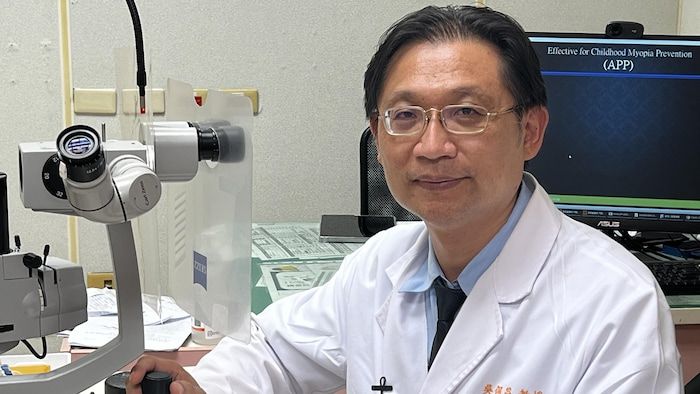
Open in full screen mode
Doctor Wu Pei Chang is at the origin of Taiwan’s myopia prevention programs.
Photo : - / Philippe Leblanc
The high intensity of daylight could stimulate the retina to produce the dopamine molecule. By increasing the production of dopamine, which is one of the neurotransmitters responsible for the growth and adjustments of the eye, we delay the onset of myopia.
explains Doctor Wu.
He convinced the Taiwanese government to launch prevention programs. A national advertising campaign emphasizes the importance of children playing outside for 120 minutes a day to benefit from the beneficial rays of the sun and improve their visual health.
These prevention programs have borne fruit in Taiwan. The prevalence of myopia among kindergarten children fell by half from 2014 to 2019.
Some 30% of the world’s population has myopia and the prevalence of this condition is increasing rapidly. It is estimated that it could reach 50% by 2050.
This growth has accelerated since the COVID-19 pandemic, according to a study by British Journal of Medicine published in September.
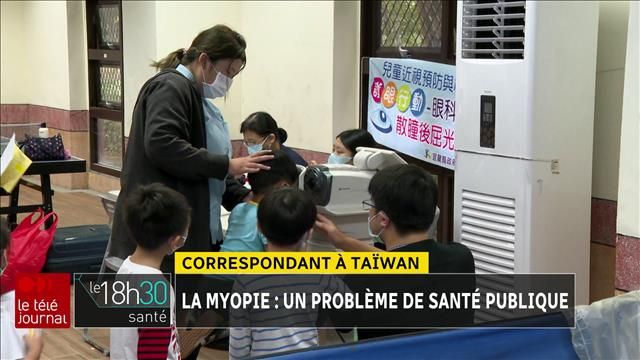
In Hong Kong, for example, the prevalence of myopia has more than doubled. In Shandong province, China, it has increased fivefold.
The scientific article calls into question the increase in time spent indoors in front of screens and, above all, the reduction in time spent playing outside due to the various containment measures.
What supports this thesis is the fact that the rate of myopia remained practically unchanged in Taiwan, which did not experience severe confinement.
The children continued their lessons in class without prolonged interruptions, says Dr Tai. We were therefore able to continue visual protection activities in schools.
Although the results of recent years seem encouraging in Taiwan, much remains to be done.
For example, of the 21 kindergarten students who took the screening test that day in late October, nine are likely to develop myopia within a few years.
Many challenges remain for the prevention of myopia and severe myopia, particularly linked to climate change. In Taiwan, classrooms are all equipped with air conditioners, which encourages children to stay indoors because it is very hot outside. Additionally, each student has a tablet for digital learning, which has increased screen time. It is therefore crucial to encourage more outdoor activities, ideally by integrating them into mandatory policies for better results
believes Doctor Wu.
Families, health professionals, schools and authorities are mobilizing to stop this silent epidemic which risks having major consequences for the entire population.

